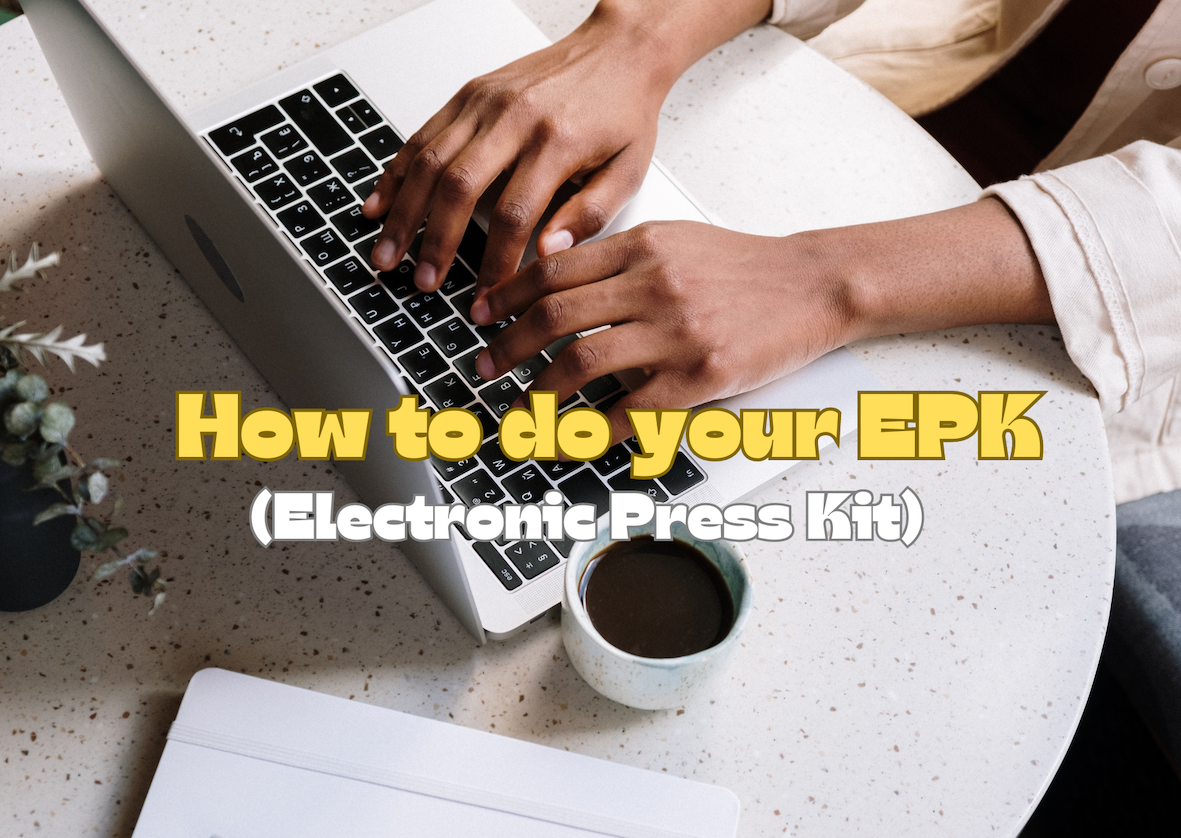Emerging artists will quickly learn the term “electronic press kit” or “EPK” when they enter the music industry. This is particularly so as they begin to pick up paid work. So as Lara Bingle would say, ‘what the bloody hell is an EPK anyway?’ The music industry experts at Yelo give us the lowdown.
What is an Electronic Press Kit or EPK?
An EPK, or electronic press kit, is a digital promotional package put together by musicians wanting to promote their band or solo act.
It’s essentially your musical identity and is a concise summary of your best work; including artist bio, photos, and links to your music.
This document creates a cohesive visual representation of your music and brand, and can be used to send journalists or booking agents when promoting your show.
Why is an EPK so important?
An EPK is used to promote you as a band or artist, and all your gigs. It can be used to send enquiring journalists, booking agents, and music industry reps.
Having a press kit on hand allows you to produce relevant material should the opportunity come knocking.
The goal of your EPK is not to overwhelm the receiver with content, but to make sense of who you are in an easy snapshot.
Pro tip: Make sure everyone in your band has an up-to-date copy, and your band manager.
How should I create my EPK?
Apps such as Canva have made putting together an EPK incredibly easy, and you can do a lot for free.
Check out this one by Sunshine Coast rock band Dellacoma:
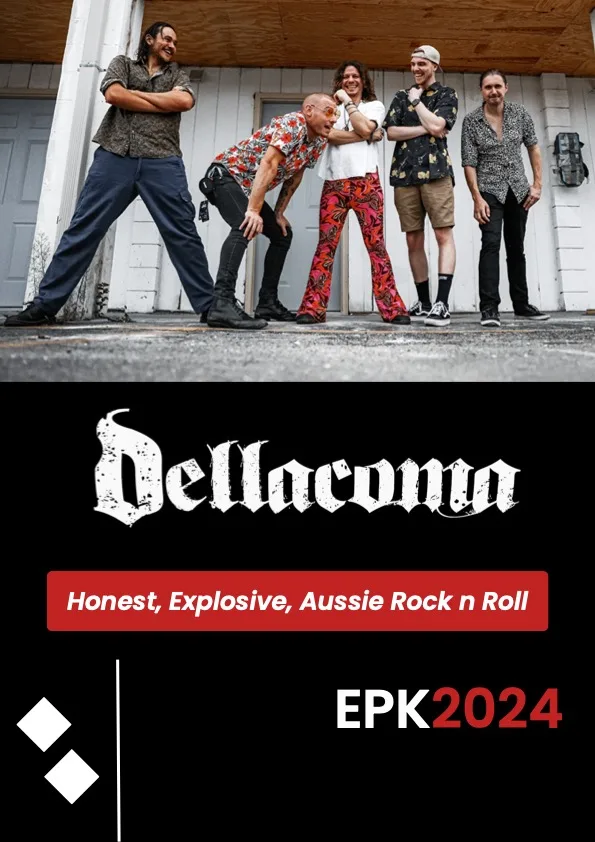
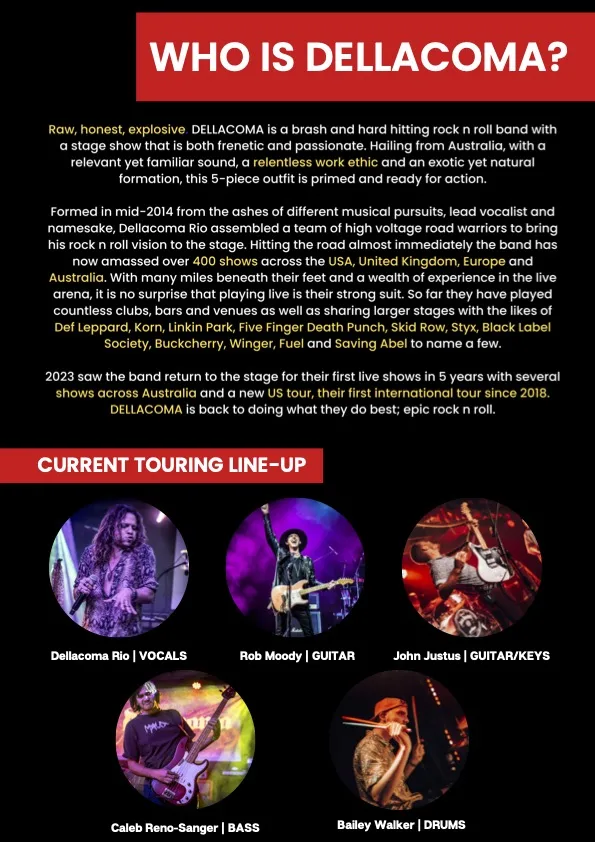

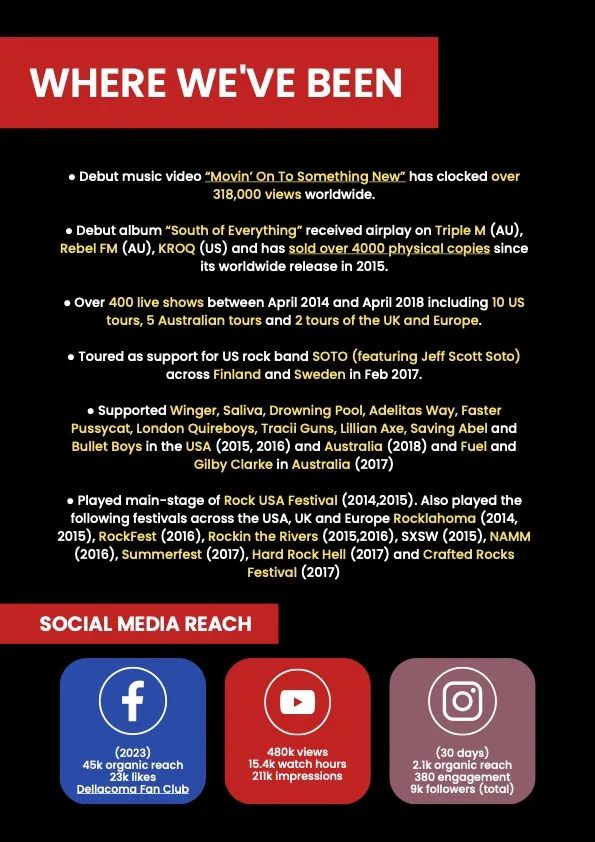
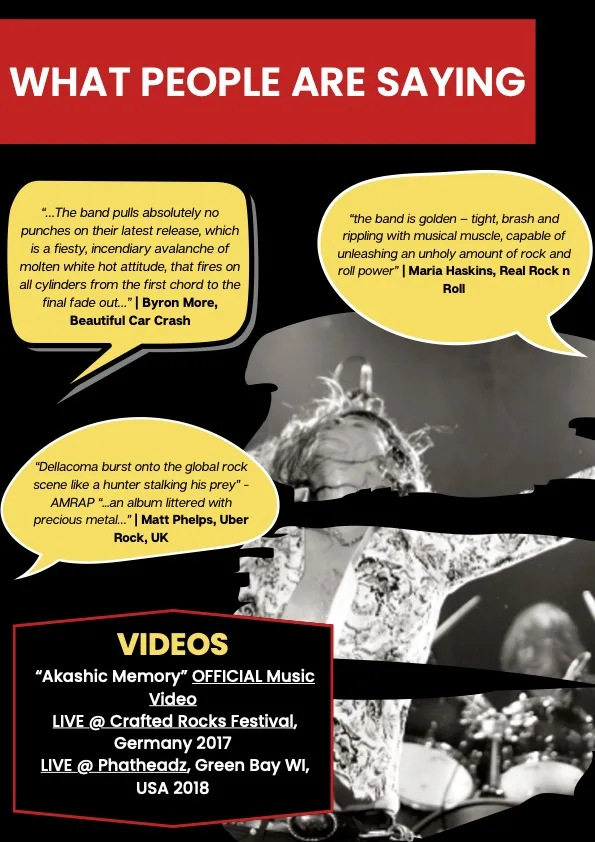
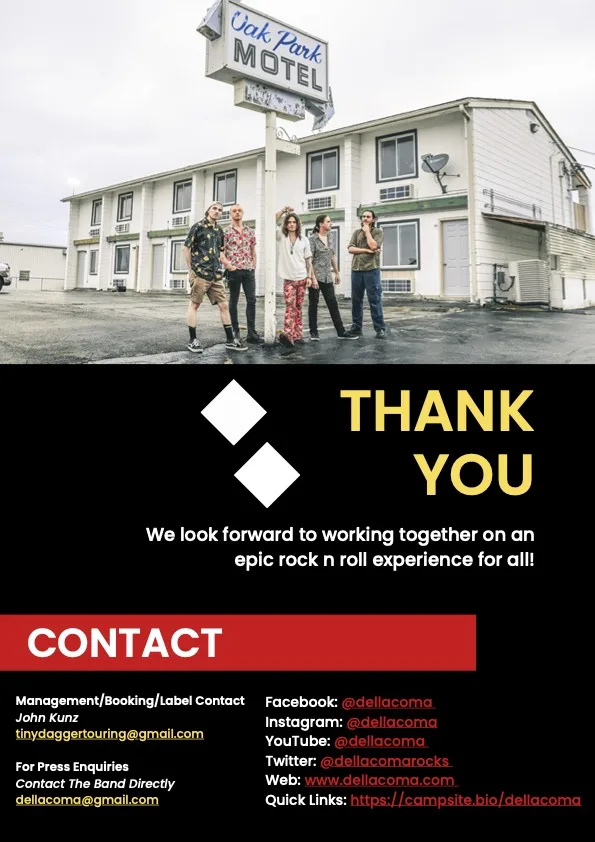
Can’t work your way around Canva? Your graphic designer friend may be able to help or source a good PR/digital marketing company.
If you’re just starting out and don’t have the accessibility and funds, it’s perfectly OK to go the old-fashioned route of attaching your photos and bio in one email.
But for the sake of ease and professionalism, work on your EPK as soon as possible.
Pro tip: Don’t forget to regularly update your EPK, including your “assets” (photos, videos, logos) and web links.
What should be included in my EPK?
- Artist bio: A summary of who you are.
- Photos: A selection of professional photos.
- Music: Links to your music such as YouYube, Spotify and SoundCloud.
- Press and testimonials: The nice things people have said about you, including press articles.
- Videos: Venues and festivals like to use videos on their websites to promote their artists.
- Social media: All your social media links in the one place, including the “reach” (how many views) each platform achieves.
- Logos and artwork (optional): Relevant artwork for your brand.
- Band timeline (optional): Your musical career highlights in a visual snapshot.
- Contact information: Band members’ phone numbers.
Need help you with your EPK? Yelo can help! Contact us here or email editor@yelo.live
Artist bio:
Your electronic press kit should start with a strong biography. This allows promoters or venues to easily understand who you are.
Start with a quick introduction of yourself (less than 100 words). This could be thought of as your “elevator pitch”. Some festivals and promoters may require varying word lengths for artist bios so have some longer versions on hand.
Pro tip: Be sure to add where you are from and your music genre, eg. five-piece alt-rock band from Perth. This is so often forgotten by artists!
Also put this information in your social media bios. Journalists are often in a hurry and may need to grab some information at a glance, without even contacting you. Don’t let the opportunity slip for getting a mention in the media.

Photos:
Your EPK should contain around five good quality photos in different sizes and styles. Include portrait and landscape options, black and whites, and live performance ones.
Musicians and photographers often use Google Drive, which makes it easy to send large files all at once.
Choose photos that align with your brand. Posed band photos are great and live shots capture your band’s energy.
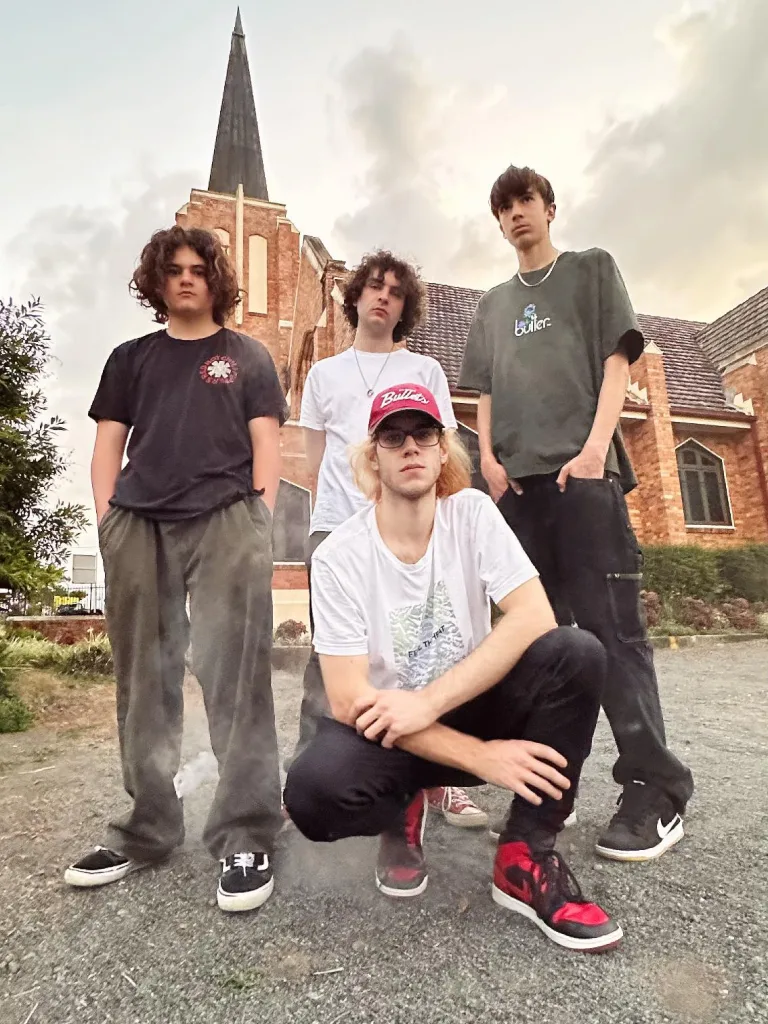
This photo of young alt-punk rockers, Acended, offers great mood and shows how a local church can provide an easy backdrop.
Pro tip: Consider how the pictures might be cropped for social media, eg. Instagram usually requires a square image. You don’t want to miss out on being featured on a platform because you didn’t have some alternate-sized photos.
Music:
Where can we find your music? Create a list of links to your best songs, but be selective. A promoter may only have time to have a quick listen to a song or two.
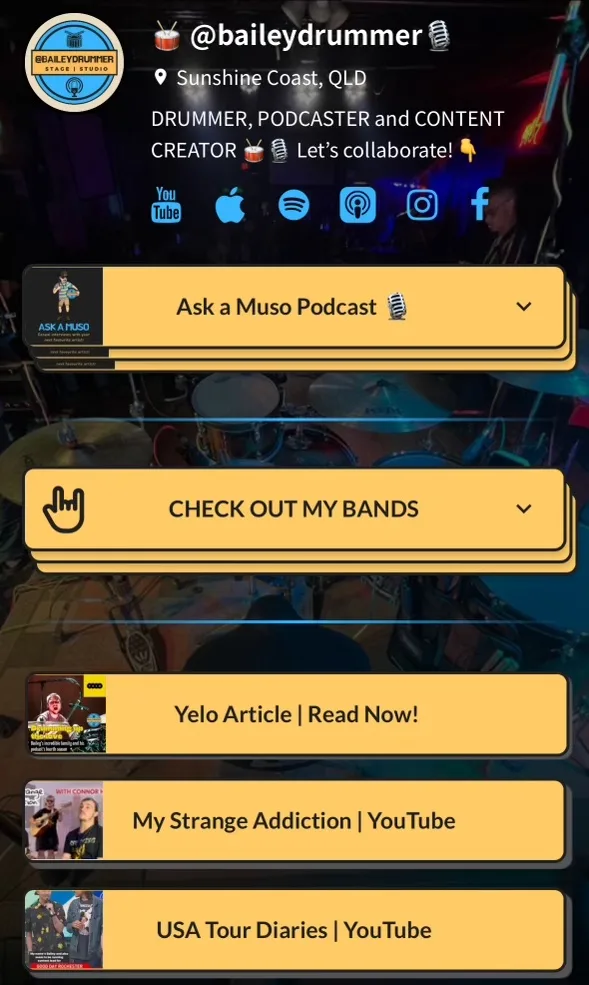
Linking platforms such as Linktr.ee or campsite.bio are perfect for this. Use this campsite.bio link for $10 off your first month!
Pro tip: Nambour musician @baileydrummer uses campsite.bio to keep all his web and music links in the one spot. He even adds links to his “Ask A Muso” podcast and recent press.
Press and testimonials:
If you’ve received press coverage it shows you have a story worth telling.
Having these available is helpful for writers when choosing a different news angle than used previously.
This is a win win for both of you, because you get to tell a new story each time, meaning more clicks and greater coverage.
Testimonials can assure bookers, especially if they can spot other bands or venues they’ve worked with.
Videos:
If you’re using your EPK to help book your shows, be sure to use live videos so that venues and bookers can see and hear you in action. Try to choose a video that’s as close to the venues you’re pitching to as possible.
Venues may require a video to aid in their promotion, such as for their website or to create a reel for their social media. Promoting a new album? Including a music video is a good tool to engage further interest in your songs.
Social media:
Highlight the social media platforms you are active on and provide each link.
You can add the monthly “reach” for each platform to show how many people are already engaged in your work. It’s super easy to find your social media insights and highlight your best stats.

Logos and artwork (optional):
Some musos have other projects on the go and may need to include relevant logos or artwork.
@baileydrummer has his own podcast and includes his logos with his artist photos in Google Drive. Pat Tierney sent Yelo his festival logo when he kick started the Sunshine Coast Blues & Roots Festival.
Band timeline (optional):
This snapshot helps music industry professionals see what you’ve done to date. Check out these simple ones for Nirvana here and here.
If your band has a long history with noteable dates it’s handy for journalists who might want to swap questions like, “when did you release your first album?” for more engaging ones.
Pro tip: Include when your band was formed, career highlights, awards you’ve won, radio success, tours, performances, and festivals.
Contact information:
Your EPK should conclude with your band members’ phone numbers and/or emails. If you have management, provide your agent or publicist’s contact details.
Pro tip: New acts often handle these roles themselves. In this case, specify who is acting as the band manager, eg. who will take phone calls from the media, etc.
Need help you with your EPK? Yelo can help! Contact us here or email editor@yelo.live

